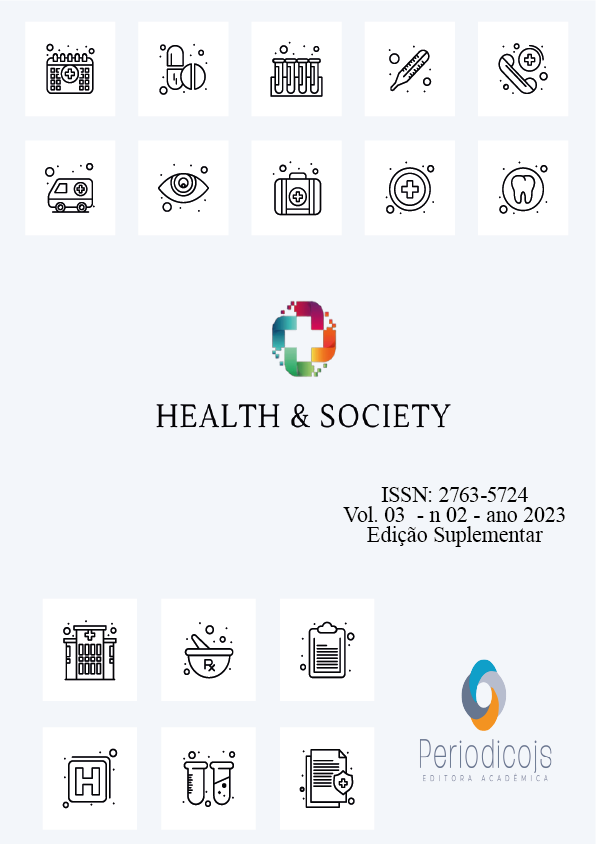Abstract
Introduction: AIDS is a chronic disease that impairs the immune system and the body’s ability to fight other infections, such as neurotoxoplasmosis, pneumocystis disease and tuberculosis. AIDS stands for Acquired Immunodeficiency Syndrome. AIDS is caused by the HIV virus, which is a sexually transmitted virus, but can also be transmitted by infected blood or vertical transmission. with a view to presenting the epidemiological incidence of AIDS cases in the northeast region of Brazil. Objective: To analyze the incidence of AIDS in young people in the Northeast region, from 2020 to 2022. Methodology: This study was carried out through a cross-sectional analysis, whose purpose was to collect and interpret the data that cover the epidemiological statistics of the incidence of AIDS in young people in the Northeast region, from 2020 to 2022. Data collection took place between June 2022 and September February 2022, using the SUS Hospital Information System (SIH/SUS) and the Unified Health System (DATASUS). Results and Discussion: In view of the evidence found, the findings indicate that, over the years, there has been a decrease in the notification of cases. Thus, in analysis, it was possible to see that compared to the years 2020 to 2022, the decline in AIDS cases was quite significant. Some factors contributed to the decrease in notifications, among them the emergence of the Covid-19 pandemic. In the peak years of the coronavirus, health services were focused on controlling the spread of the virus, thus many other notifiable diseases were neglected, including AIDS. In addition to this, it is highlighted that not all data during this period are reliable. Conclusion: It was noticeable that the notification occurred more frequently among 19-year-olds and the state with the highest notification was Bahia in all the added criteria. Therefore, the objective of this study was achieved, demonstrating the most relevant data on the subject. Therefore, it is proposed that more studies be carried out on the subject.
References
AGUIAR, Tamires Saraiva et al. Perfil epidemiológico de HIV/AIDS no Brasil com base nos dados provenientes do DataSUS no ano de 2021. Research, Society and Development, v. 11, n. 3, p. e4311326402-e4311326402, 2022.
BEZERRA, Ancleiton; MUSSATO, Osvair Brandão; DAS NEVES RODRIGUES, Heila Antonia. Geografia da AIDS em Roraima: Perfil epidemiológico dos soropositivos. Ambiente: Gestão e Desenvolvimento, v. 15, n. 2, p. 19-31, 2022.
CARVALHO, Jamille Maria Rodrigues; MONTEIRO, Simone Souza. Visões e práticas de mulheres vivendo com HIV/aids sobre reprodução, sexualidade e direitos. Cadernos de Saúde Pública, v. 37, 2021.
CRIMP, Douglas. Retratos de Pessoas com AIDS. In: O Corpo. Routledge, 2020. p. 204-207.
CAMILLO, Ana Julia Gonçalves et al. Fatores associados ao óbito por tuberculose e HIV/aids em presídios: revisão integrativa. Acta Paulista de Enfermagem, v. 35, 2022.
JAISWAL, J.; LOSCHIAVO, C.; PERLMAN, D. C. Desinformação, desinformação e desconfiança impulsionada pela desigualdade em tempos de COVID-19: lições não aprendidas do negacionismo da AIDS. AIDS e Comportamento, v. 24, p. 2776-2780, 2020.
JÚNIOR, Ivanildo Gonçalves Costa et al. Perfil epidemiológico HIV/AIDS no estado do piauí em 2019. Revista Ciência Plural, v. 8, n. 1, p. e25682-e25682, 2022.
LEITE, Marinês Tambara; MOURA, Cristiano de; BERLEZI, Evelise Moraes. Doenças sexualmente transmissíveis e HIV/AIDS na opinião de idosos que participam de grupos de terceira idade. Revista Brasileira de Geriatria e Gerontologia, v. 10, p. 339-354, 2019.
PIZZATTO, Tainara Christina; SIGNORATI, Mateus; SIGNORATI, Adrieli. Perfil Epidemiológico do HIV/Aids da 7ª Regional de Saúde do Estado do Paraná, no Período de 2009-2019. Research, Society and Development, v. 11, n. 8, p. e33811830288-e33811830288, 2022.
REMIEN, Robert H. et al. Saúde mental e VIH/SIDA: a necessidade de uma resposta integrada. AIDS (Londres, Inglaterra), v. 33, n. 9, p. 1411, 2019.
SILVA, Eleni Maria et al. Perfil epidemiológico da AIDS na terceira idade no município de Aracaju–Sergipe. Research, Society and Development, v. 11, n. 10, p. e286111032810-e286111032810, 2022.
TEIXEIRA, Lívia Garcia et al. O perfil epidemiológico da AIDS no Brasil The epidemiological profile of AIDS in Brazil. Brazilian Journal of Health Review, Curitiba, v. 5, n. 1, p. 1980-1992, 2022.
WITTEMAN, Holly O. et al. Desenvolvimento sistemático de auxiliares de decisão do paciente: uma atualização da colaboração IPDAS. Tomada de Decisão Médica, v. 41, n. 7, p. 736-754, 2021.
ZICARI, Sonia et al. Ativação imunológica, inflamação e comorbidades não relacionadas à AIDS em pacientes infectados pelo HIV sob TARV de longo prazo. Vírus, v. 11, n. 3, p. 200, 2019.
ZORNITTA, Marlene. Os novos idosos com aids: sexualidade e desigualdade à luz da bioética. Editora Dialética, 2022.

This work is licensed under a Creative Commons Attribution 4.0 International License.
Copyright (c) 2023 Tamires Costa Duart, Winícius de Carvalho Alves, Danilo Barbosa Resende, Jéssica Sthefanye Urçulino Dorneles, Yara da Silva Viana Paulo da Costa Araújo, Wallace Irwin Flores Souza, Gustavo José Matos da Silva, Arthemis Vieira Benevides Ferreira





